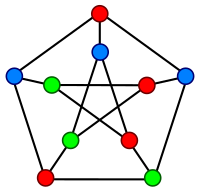
Photo from wikipedia
Graph coloring is one of the most studied problems in graph theory due to its important applications in task scheduling and pattern recognition. The main aim of the problem is… Click to show full abstract
Graph coloring is one of the most studied problems in graph theory due to its important applications in task scheduling and pattern recognition. The main aim of the problem is to assign colors to the elements of a graph such as vertices and/or edges subject to certain constraints. The 1-harmonious coloring is a kind of vertex coloring such that the color pairs of end vertices of every edge are different only for adjacent edges and the optimal constraint that the least number of colors is to be used. In this paper, we investigate the graphs in which we attain the sharp bound on 1-harmonious coloring. Our investigation consists of a collection of basic graphs like a complete graph, wheel, star, tree, fan, and interconnection networks such as a mesh-derived network, generalized honeycomb network, complete multipartite graph, butterfly, and Benes networks. We also give a systematic and elegant way of coloring for these structures.
Journal Title: Symmetry
Year Published: 2019
Link to full text (if available)
Share on Social Media: Sign Up to like & get
recommendations!